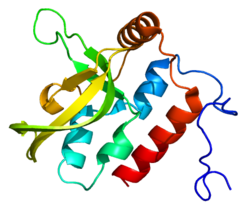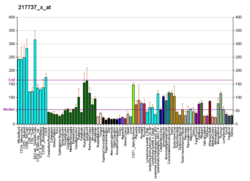| RTF1 |
|---|
 |
| Available structures |
|---|
| PDB | Ortholog search: PDBe RCSB |
|---|
| List of PDB id codes |
|---|
2BZE, 2DB9, 3U1U, 4L1P, 4L1U |
|
|
| Identifiers |
|---|
| Aliases | 15890 RTF1, RTF2, GTL7, KIAA0252, RTF1 homolog, Paf1/RNA polymerase II complex component, RTF2, C20orf43, CDAO5, HSPC164, SHUJUN-3, replication termination factor 2 domain containing 1, replication termination factor 2, RTFDC1 |
|---|
| External IDs | OMIM: 611633; MGI: 1309480; HomoloGene: 133868 9501; GeneCards: RTF2 RTF1, RTF2; OMA:RTF1, RTF2 - orthologs |
|---|
| Gene location (Human) |
|---|
 | | Chr. | Chromosome 15 (human)[1] |
|---|
| | Band | 15q15.1, 20q13.31 | Start | 41,408,408 bp[1] |
|---|
| End | 41,483,563 bp[1] |
|---|
|
| Gene location (Mouse) |
|---|
 | | Chr. | Chromosome 2 (mouse)[2] |
|---|
| | Band | 2|2 E5 | Start | 119,675,068 bp[2] |
|---|
| End | 119,735,407 bp[2] |
|---|
|
| RNA expression pattern |
|---|
| Bgee | | Human | Mouse (ortholog) |
|---|
| Top expressed in | - ganglionic eminence
- Skeletal muscle tissue of rectus abdominis
- palpebral conjunctiva
- epithelium of colon
- ventricular zone
- bone marrow cells
- cerebellar hemisphere
- Skeletal muscle tissue of biceps brachii
- body of tongue
- monocyte
|
| | Top expressed in | - tail of embryo
- zygote
- genital tubercle
- hand
- yolk sac
- superior cervical ganglion
- foot
- interventricular septum
- primitive streak
- fossa
|
| | More reference expression data |
|
|---|
| BioGPS |  | | 51507/ More reference expression data |
|
|---|
|
| Gene ontology |
|---|
| Molecular function | - protein binding
- single-stranded DNA binding
- DNA binding
- RNA polymerase II C-terminal domain phosphoserine binding
- RNA binding
- molecular function
| | Cellular component | - nucleolus
- nucleus
- Cdc73/Paf1 complex
- nucleoplasm
- cellular component
- replication fork
- chromosome
| | Biological process | - blastocyst growth
- histone modification
- regulation of transcription, DNA-templated
- positive regulation of transcription elongation from RNA polymerase II promoter
- histone H3-K4 trimethylation
- positive regulation of histone H3-K4 methylation
- transcription, DNA-templated
- Wnt signaling pathway
- positive regulation of transcription by RNA polymerase II
- negative regulation of transcription by RNA polymerase II
- stem cell population maintenance
- endodermal cell fate commitment
- transcription by RNA polymerase II
- transcription elongation from RNA polymerase II promoter
- protein ubiquitination
- mitotic DNA replication termination
- site-specific DNA replication termination at RTS1 barrier
- biological process
- cellular response to hydroxyurea
- regulation of DNA stability
| | Sources:Amigo / QuickGO |
|
| Orthologs |
|---|
| Species | Human | Mouse |
|---|
| Entrez | | |
|---|
| Ensembl | |
|---|
ENSG00000137815
ENSG00000022277 |
| |
|---|
| UniProt | | |
|---|
| RefSeq (mRNA) | |
|---|
NM_015138
NM_001283035
NM_001283036
NM_001283037
NM_016407 |
| |
|---|
| RefSeq (protein) | |
|---|
NP_055953
NP_001269964
NP_001269965
NP_001269966
NP_057491 |
| |
|---|
| Location (UCSC) | Chr 15: 41.41 – 41.48 Mb | Chr 2: 119.68 – 119.74 Mb |
|---|
| PubMed search | [3] | [4] |
|---|
|
| Wikidata |
| View/Edit Human | View/Edit Mouse |
|



















